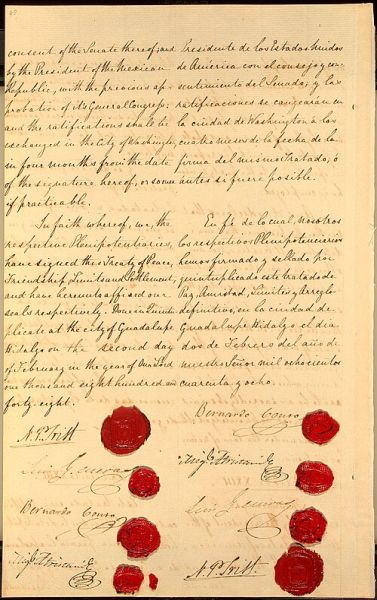Adapted Excerpt 1: Article V
The boundary line between the two Republics will begin in the Gulf of Mexico, opposite the mouth of the Rio Grande (also called Rio Bravo del Norte). It will run up the middle of that river until it reaches the southern border of New Mexico. From there, the line will go west along the southern boundary of New Mexico to its end, then north along the western boundary until it meets the first branch of the Gila River. It will follow the Gila River down to where it joins the Colorado River, then cross over and continue to the Pacific Ocean, one league south of the southernmost point of San Diego.
To prevent any disagreement, both governments will appoint a commissioner and a surveyor. They will meet at San Diego within one year to mark the line on the ground and record their work. Their final maps and journals will become part of this treaty and hold the same authority.
This boundary shall be respected by both nations, and it shall not be changed unless both governments freely agree to do so.
Adapted Excerpt 2: Article VII
The Gila River and the part of the Rio Grande that lies below the southern boundary of New Mexico will, according to the fifth article, be divided down the middle between the two republics. The navigation of these rivers shall be open and shared by the citizens and ships of both countries. Neither side may, without the consent of the other, build anything that blocks or interferes with this right, not even for improving travel on the water. No tax or fee of any kind shall be charged on people, ships, or goods moving along the rivers, unless they land on one of the shores. If it becomes necessary to collect a tax in order to improve or maintain navigation on these rivers, it cannot be done without the agreement of both governments.
The agreements in this article shall not take away the territorial rights of either republic within its own boundaries.
Adapted Excerpt 3: Article XII
In return for the new land added to the United States, as stated in the fifth article of this treaty, the Government of the United States agrees to pay the Government of Mexico the sum of fifteen million dollars.
Right after the treaty is approved by the Mexican Government, the United States will pay three million dollars in the city of Mexico, using gold or silver coins of Mexico. The other twelve million dollars will be paid in the same place, in the same type of coins, in yearly payments of three million dollars each. Interest at the rate of six percent per year will be added to the twelve million, beginning on the day the Mexican Government ratifies the treaty. The first of the yearly payments will be made one year from that day. With each yearly payment, the full interest that has built up on that payment will also be paid.

